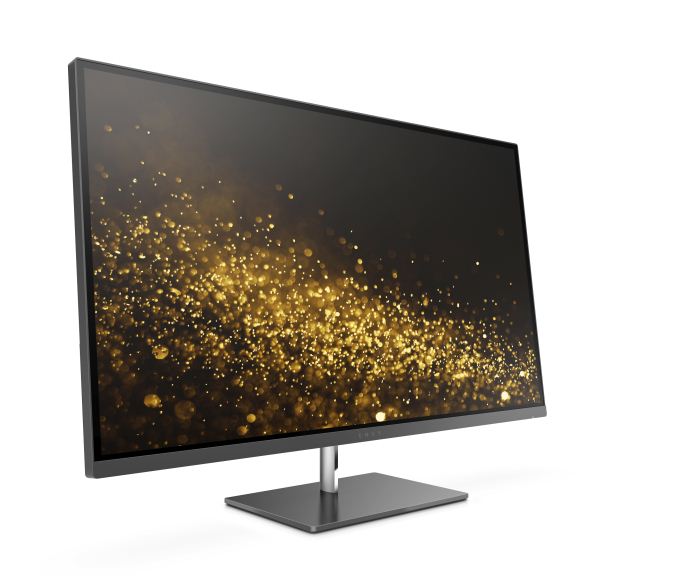HP Announces The HP ENVY 27 4K Thin Bezel Display
by Brett Howse on October 12, 2016 12:30 AM EST
Today HP announced an update to their product lineup, and one of the announcements that caught my eye immediately was the new ENVY 27 display. HP has packed a lot of features into a great looking display, but best of all it’s going to be available for $499.
The 27-inch display is an IPS panel, and although HP doesn’t list the refresh rate, it is likely going to be 60 Hz. It also supports FreeSync, meaning it should help with image tearing when gaming at 4K, where the high resolution really taxes even the strongest cards. The benefits won’t be as pronounced as some higher refresh rate gaming displays, but regardless it is better to have this than not.
HP is also promoting that the “sRGB color accuracy exceeds 99 percent” which sounds like they don’t mean what they are saying. Accuracy is generally measured in Delta E, where lower is better, and gamut coverage is measured in percentage. With full sRGB gamut coverage, hopefully they have spent a bit of effort on panel calibration, and if so they will have a pretty nice display for the money.
It also features DisplayPort, HDMI, and USB-C for connectivity, and the latter can also charge your laptop or phone with up to 60 Watts of power. That means this can be a single cable connection to drive the display and power the laptop, which is exactly what USB-C is designed to achieve, and it’s great to see more products supporting this. For a desktop, it is less important, but if you want to dock your laptop, a single cable will give you display, and power.
The design is a thin bezel, with a chrome finished support mounting the display to the base. There is no mention of height adjustment, and the images are unclear.
As already mentioned, this 27-inch 4K IPS FreeSync display will be price at just $499, with availability starting December 4th.
Source: HP via Windows Blog












37 Comments
View All Comments
jj-lucifer - Wednesday, October 12, 2016 - link
Sigh....when will we start seeing HDR monitors? 27-32" 1080p or 1440p monitor with HDR is all I need....Toss3 - Wednesday, October 12, 2016 - link
Couldn't agree more. Seems like these companies are basically trying to milk every dime they can out of these older panels before they go extinct when HDR and full coverage DCI-P3 displays start hitting the market. 99% sRGB - Who cares?Thayios - Wednesday, October 12, 2016 - link
That's exactly what they are doing. I'm stuck on my Ultrasharps until that happenstuxRoller - Thursday, October 13, 2016 - link
Forget dcip3. It's color space is basically a translated Adobe rgb (basically no increase in labspace coverage).I really hope they jump straight to rec2100 with its much greater ability to represent greens and required support of hdr (and attendant, more efficient, transfer function).
nirolf - Wednesday, October 12, 2016 - link
I'm waiting for that too. I'm not buying anything that's not HDR ready. Does Windows 10 support HDR?damianrobertjones - Wednesday, October 12, 2016 - link
What you need to ask is... Does nVidia/AMD support HDR? Is yes then... Windows 10 supports HDR.Thayios - Wednesday, October 12, 2016 - link
Windows 10 Anniversary Edition supports HDR with the proper GPUVisual - Thursday, October 13, 2016 - link
I get what HDR means in image formats - basically just using floating-point color to be able to represent even slight differences in colors accurately; or in camera sensors - being able to capture those slight differences (though last I looked lots of "HDR" cameras actually cheat their way around by taking several shots at different exposure).But what does HDR mean in a monitor? What good does it do to me if the monitor is able to understand 0% light and 0.0001% light and 0.0000001% light as different light levels or even show them accurately if my eye does not distinguish them anyway?
The value of HDR formats and cameras is in post-processing, when you can select to change the exposure and view different parts of the range so the slight differences become noticeable. Monitor support for HDR makes no sense to me.
nirolf - Thursday, October 13, 2016 - link
Why do you say you cannot distinguish between colors? The human eye can see more colors than current displays can show. Check this out: http://www.tftcentral.co.uk/articles/content/point...The Pointer’s gamut is (an approximation of) the gamut of real surface colors as can be seen by the human eye, based on the research by Michael R. Pointer (1980). What this means is that every color that can be reflected by the surface of an object of any material is inside the Pointer’s gamut.
[...]
Rec. 709 / sRGB
The ITU-R Recommendation BT. 709, or simply Rec. 709, standardizes the format of high-definition television, first approved in 1990. [...] When plotted in either the CIE 1931 xy or CIE 1976 u’v’ chromaticity diagram it immediately becomes apparent that this is a fairly small color space. In the CIE 1931 xy chromaticity diagram it covers only 33.5% of the chromaticities and 69.4% of Pointer’s gamut. In CIE 1976 u’v’ these values are 33.2% and 70.2% respectively.
DCI-P3
In the CIE 1931 xy chromaticity diagram the DCI-P3 color space covers 45.5% of all chromaticities and 86.9% of Pointer’s gamut. In the CIE 1976 u’v’ chromaticity diagram the coverage is 41.7% and 85.5% respectively.
Rec. 2020
The resulting colors space covers 63.3% of all chromaticities and 99.9% of Pointer’s gamut in the CIE 1931 xy chromaticity diagram, in the CIE 1976 u’v’ chromaticity diagram these are 57.2% and 99.7%.
Visual - Thursday, October 13, 2016 - link
Ok, so it's actually about a wider color space, while I seem to associate the term HDR with distinguishing close values within the color space instead. Good to know. The linked article is an interesting read, thanks.